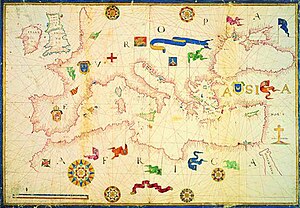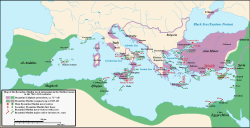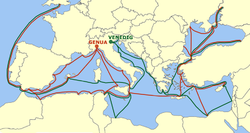History of the Mediterranean region

The history of the Mediterranean region and of the cultures and people of the
Early history

There is evidence of stone tools on Crete in 130,000 years BC,[4][5] which indicates that early humans were capable of using boats to reach the island.
The cultural stage of
The Black Sea area is a cradle of the European civilization. The site of Solnitsata (5500 BC - 4200 BC) is believed to be the oldest town in Europe - prehistoric fortified (walled) stone settlement (prehistoric city).[6][7][8][9] The first gold artifacts in the world appear from the 5th millennium BC, such as those found in a burial site from 4569–4340 BC and one of the most important archaeological sites in world prehistory – the Varna Necropolis near Lake Varna in Bulgaria, thought to be the earliest "well-dated" find of gold artifacts.[10]
As of 1990, gold artifacts found at the Wadi Qana cave cemetery of the 4th millennium BC in the West Bank were the earliest from the Levant.[11]
The
The
While the cultural advances during the Bronze Age had mostly been confined to the eastern parts of the Mediterranean, with the Iron Age, the entire coastal region surrounding the Mediterranean now becomes involved, significantly due to the
The Phoenicians and the Assyrians transported elements of the Late Bronze Age culture of the Near East to Iron Age
Classical antiquity

Two of the most notable Mediterranean civilizations in
Persian period
From the 6th century BC up to including the first half of the 4th century BC, many of the significant Mediterranean peoples came under
Hellenistic period

In the northernmost part of ancient Greece, in the ancient kingdom of
The major centres of the Mediterranean at the time became part of Alexander's empire as a result. His empire quickly disintegrated, and the Middle East, Egypt, and Greece were soon again independent. Alexander's conquests spread Greek knowledge and ideas throughout the region.
Roman–Carthaginian rivalry
These eastern powers soon began to be overshadowed by those farther west. In North Africa, the former Phoenician colony of Carthage rose to dominate its surroundings with an empire that contained many of the former Phoenician holdings. However, it was a city on the Italian Peninsula, Rome, that would eventually dominate the entire Mediterranean basin. Spreading first through Italy, Rome defeated Carthage in the Punic Wars, despite Hannibal's famous efforts against Rome in the Second Punic War.
After the Third Punic War, Rome then became the leading force in the Mediterranean region. The Romans soon spread east, taking Greece, and spreading Latin knowledge and ideas throughout the place. By this point the coastal trading cultures were thoroughly dominant over the inland river valleys that had once been the heart of the great powers. Egyptian power moved from the Nile cities to the coastal ones, especially Alexandria. Mesopotamia became a fringe border region between the Roman Empire and the Persians.
Roman Mare Nostrum

When
The empire began to crumble, however, in the fifth century and Rome collapsed after 476 AD.
Sasanian and Byzantine times
The Eastern Roman or
Middle Ages
Another power was rising in the east, that of
The Arab invasions disrupted the trade relations between Western and Eastern Europe while cutting the trade route with Oriental lands. This however had the indirect effect of promoting the trade across the Caspian Sea. The export of grains from Egypt was re-routed towards the Eastern world. Oriental goods like silk and spices were carried from Egypt to ports like Venice and Constantinople by sailors and Jewish merchants. The Viking raids further disrupted the trade in western Europe and brought it to a halt. However, the Norsemen developed the trade from Norway to the White Sea, while also trading in luxury goods from Spain and the Mediterranean. The Byzantines in the mid-8th century retook control of the area around the north-eastern part of the Mediterranean. Venetian ships from the 9th century armed themselves to counter the harassment by Arabs while concentrating trade of oriental goods at Venice.[22]
The powerful and long-lived Bulgarian Empire was the main European rival in the region of the Mediterranean
In
Between 831 and 1071, the Emirate of Sicily was one of the major centres of Islamic culture in the Mediterranean. After its conquest by the Christian Normans, the island developed its own distinct culture with the fusion of Latin and Byzantine influences. Palermo remained a leading artistic and commercial centre of the Mediterranean well into the Middle Ages.

The
More organized and centralized states gradually began to form in Europe during the later
The Crusades led to flourishing of trade between Europe and the
The
Slavery

Slavery was a strategic and very important part of all Mediterranean societies during the Middle Ages. The threat of becoming a slave was a constant fear for peasants, fishermen and merchants. Those with money or who had financial backing only feared the lack of support, should they be threatened with abduction for ransom.
There were several things which could happen to people in the Mediterranean region of the Middle Ages:
- When commerce raidersplied their trade, a peasant, fisherman or coastal villager, who had no financial backing, could be abducted or sold to slave traders, or adversaries, who made large profits on an international market;
- If the captive was wealthy or had influential supporters, the captive could be ransomed. This would be the most advantageous plan, since the money exchange was immediate and direct, not long and drawn out as in the slave market business;
- The captive could be used immediately by the corsair for labour on the ship rather than traded. In battles during this era, prisoners of war were often captured and used as slaves.
Emperors would take large numbers of prisoners, parade them through the capital, hold feasts in honour of their capture and parade diplomats in front of them as a display of victory.[31]
Late Middle Ages

The "Repubbliche Marinare" (
The Republic of Venice got to dominate the eastern mediterranean shores after the Fourth Crusade.[32]
Between 1275 and 1344 a struggle for the control of the
In 1347 the Black Death spread from Constantinople across the mediterranean basin.[34]
Ottoman power continued to grow, and in 1453, the Byzantine Empire was extinguished with the
Ceuta was ultimately taken by the Kingdom of Portugal in 1415, searching to undermine Castilian, Aragonese, and Genoese interests in the area.[35]
During the Middle Ages, rival Christian and Muslim kingdoms forbade the trade of particular goods to enemy kingdoms including weaponry and other contraband items. The popes forbade the export of these commodities to the Islamic world. The Ottomans too forbade the export of weapons and other strategic items, declaring them memnu eşya or memnu olan to Christian states even in peace treaties, however friendly states could import some of the prohibited goods through capitulations. Despite these prohibitions, trade of contraband occurred on both sides. The European merchants traded in illegal goods with Muslims. The Ottomans were unable to suppress the trade with smuggling being undertaken mainly in the winter when the Ottoman Navy stationed at the Istanbul Arsenal was unable to stop Ottoman and non-Ottoman vessels from indulging in the trade.[36]
Modern era


The growing naval prowess of the European powers confronted further rapid Ottoman expansion in the region when the
A
The development of long range seafaring had an influence upon the entire Mediterranean. While once all trade from the east had passed through the region, the
to be imported directly to the Atlantic ports of western Europe. The Americas were also a source of extreme wealth to the western powers, from which some of the Mediterranean states were largely cut off.The base of European power thus shifted northward and the once wealthy Italy became a peripheral area dominated by foreigners. The Ottoman Empire also began a slow decline that saw its North African possessions gain de facto independence and its European holdings gradually reduced by the territorial gains of Austria and the Russian Empire. In the wake of the aftermath of the 1768–1774 Russo-Turkish War, the Russian empire gained direct access to the Black Sea.[37]
By the nineteenth century the European States were vastly more powerful, and began to colonize North Africa. France spread its power south by starting their conquest of the
During the first half of the twentieth century the Mediterranean was at the center of the expansion of the
Today, the Mediterranean Sea is the southern border of the European Union and represents one of the largest area by Trade in the World. The Maltese prime minister described the Mediterranean sea as a "cemetery" due to the large amounts of migrants who drown there.[39] Following the 2013 Lampedusa migrant shipwreck, the Italian government, has decided to strengthen the national system for the patrolling of the Mediterranean Sea by authorizing Operation Mare Nostrum, a military and humanitarian operation in order to rescue the migrants and arrest the traffickers of immigrants.[40]
See also
- Eastern Mediterranean
- History of Anatolia
- History of Europe
- History of the Middle East
- History of North Africa
- History of the Levant
- History of Western civilization
- Life zones of the Mediterranean region
- Mediterranean Basin
- Union for the Mediterranean
References
- ISBN 978-0-8047-5755-3.
- ^ "The Human Journey: Early Settlements in Europe". www.humanjourney.us. Retrieved 24 March 2017.
Human fossil evidence from sites such as Atapuerca in Spain suggests that they were a form of Homo erectus (sometimes called Homo ergaster).
- ^ National Geographic Italia – Erano padani i primi abitanti d'Italia Archived 2019-06-26 at the Wayback Machine(in Italian)
- ^ Wilford, John Noble (15 February 2010). "Discovery Dates Seafaring 100,000-Plus Years Ago". New York Times. Archived from the original on 10 October 2018. Retrieved 27 October 2018.
- ^ "Hominids Went Out of Africa on Rafts". Wired. Archived from the original on 19 November 2018. Retrieved 27 October 2018.
- The Los Angeles Times. Retrieved 1 November 2012.
- ^ Survival of Information: the earliest prehistoric town in Europe
- ^ Squires, Nick (31 October 2012). "Archaeologists find Europe's most prehistoric town". The Daily Telegraph. Retrieved 1 November 2012.
- ^ Nikolov, Vassil. "Salt, early complex society, urbanization: Provadia-Solnitsata (5500-4200 BC) (Abstract)" (PDF). Bulgarian Academy of Sciences. Retrieved 1 November 2012.
- ISBN 978-0-674-03590-4. Retrieved 10 April 2012.
- S2CID 143173212.
- ISBN 978-0-691-02591-9.
- ^ See A. Stoia and the other essays in M.L. Stig Sørensen and R. Thomas, eds., The Bronze Age—Iron Age Transition in Europe (Oxford) 1989, and T.A. Wertime and J.D. Muhly, The Coming of the Age of Iron (New Haven) 1980.
- ISBN 0-19-860641-9,"page 1515,"The Thracians were subdued by the Persians by 516"
- ISBN 144435163X
- ISBN 978-1-4443-5163-7. Archivedfrom the original on 22 April 2016. Retrieved 17 December 2014.
- ISBN 978-1-84603-108-3.
- ^ Diodorus Siculus, Arrian
- ^ Daniel Fuks, Avner Ayalon, et al., "Dust clouds, climate change and coins: consiliences of palaeoclimate and economy in the Late Antique southern Levant", Journal of the Council for British Research in the Levant 49/2 (Oct. 2017): 205-223. Download citation https://doi.org/10.1080/00758914.2017.1379181
- ^ Crawford, Peter (2013). The War of the Three Gods: Romans, Persians and the Rise of Islam. Pen and Sword.
- ISBN 978-1-317-35150-4. Archivedfrom the original on 2018-09-13. Retrieved 2018-09-20.
- ^ Subhi Y. Labib (1969), "Capitalism in Medieval Islam", The Journal of Economic History 29 (1), p. 79–96 [80].
- ISBN 978-0-521-78151-0. Archivedfrom the original on 2018-09-13. Retrieved 2018-09-20.
- ISBN 978-1-4051-1189-8.
- ISBN 978-1-135-94880-1. Archivedfrom the original on 2018-09-13. Retrieved 2018-09-20.
- ^ Baadj 2015, p. 1.
- ISBN 978-90-04-29620-6.
- ISBN 978-84-89014-76-3.
- ^ Baadj 2015, p. 2.
- ISBN 978-0-691-14705-5.
- ^ Banaji 2007, p. 62-63.
- ^ a b López 1996–1997, p. 405.
- ^ Sola 2006, p. 46.
- ^ Banaji 2007, pp. 49, 63–64.
- ^ Ga ́bor A ́goston; Bruce Alan Masters. Encyclopedia of the Ottoman Empire. Infobase Publishing. p. 145.
- ^ Toucas, Boris (2 February 2017). "The Geostrategic Importance of the Black Sea Region: A Brief History". CSIC.
- ^ Mary Pelletier "A brief history of the Suez Canal" In: Apollo 3.7.2018; Hans Reis "Der Suezkanal – die wichtigste von Menschen geschaffene Wasserstrasse wurde vor 150 Jahren gebaut und war oft umkämpft" In: Neue Zürcher Zeitung 17.11.2019.
- ^ "Migrant deaths prompt calls for EU action". Al Jazeera. 13 October 2013. Archived from the original on 1 August 2018. Retrieved 27 October 2018.
- ^ "L'OPERAZIONE MARE NOSTRUM | eurasia-rivista.org". Archived from the original on 2014-07-18. Retrieved 2014-08-01.
Bibliography
- Banaji, Jairus (2007). "Islam, the Mediterranean and the Rise of Capitalism" (PDF). ISSN 1465-4466.
- López, María Dolores (1996–1997). "De nuevo sobre la "guerra del Estrecho" la contribución financiera del reino de Valencia en la última fase del conflicto (1332–1344)" (PDF). Anales de la Universidad de Alicante. Historia medieval (11). Alicante: ISSN 0212-2480.
- Sola, Emilio (2006). "The Mediterranean, dynamic centre of the 14th century". In María Jesús Viguera Molins (Coord.) (ed.). Ibn Khaldun: The Mediterranean in the 14th Century: Rise and Fall of Empires. Foundation José Manuel Lara. pp. 40–49. ISBN 84-96556-34-4.
Further reading
- ISBN 978-0-19-532334-4.
- Bohlman, Philip V.; Keller, Marcello Sorce; Azzaroni, Loris (eds.), Musical Anthropology of the Mediterranean: Interpretation, Performance, Identity, Bologna, Edizioni Clueb – Cooperativa Libraria Universitaria Editrice, 2009.
- Annales School
- ISBN 978-0-19-999978-1.
- Burke, III, Edmund. "Toward a Comparative History of the Modern Mediterranean, 1750–1919," Journal of World History (2012) 23:4.pp. 907–939. DOI: 10.1353/jwh.2012.0133
- Chambers, Iain. Mediterranean Crossings: The Politics of an Interrupted Modernity (Duke University Press, 2008).
- Horden, Peregrine and Nicholas Purcell. The Corrupting Sea: A Study of Mediterranean History. Malden, MA: Blackwell, 2000.
- Horden, Peregrine and Purcell, Nicholas. "The Mediterranean and 'the New Thalassology'" American Historical Review (2006) 111#3 pp 722–740 online
- Marino, John A. (2003) "The Exile and His Kingdom—The Reception of Braudel's Mediterranean," Sixteenth Century Journal 34:4.
- Rogerson, Barnaby. The Last Crusaders: The Hundred-Year Battle for the Center of the World (Overlook Press; 2010) 482 pages. Traces power struggles in the Mediterranean between 1450 and 1590.
- Thiollet, Jean-Pierre. Je m'appelle Byblos.
- Schlicht, Alfred, "Die Araber und Europa" Stuttgart 2008 (Kohlhammer Verlag)
- Sorce Keller, Marcello. "Mediterranean", Janet Sturman (ed.) The SAGE Encyclopedia of Music and Culture. Los Angeles: SAGE Reference, 2019, Vol. III, 618-623.
